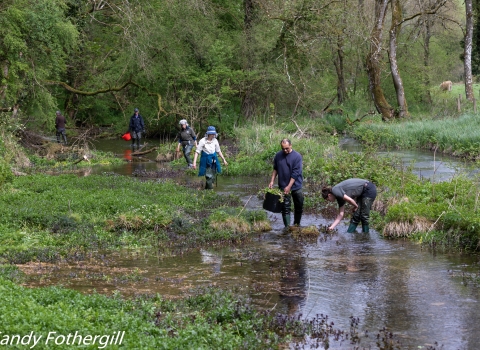Background of the project
Within the Windrush Valley lie two historical watercress beds that are fed with Springwater, which gushes out of the banks and overflows into the River Windrush. This pure water is contained by low walls built from local stone, creating two distinct compounds, which are then sub-divided by smaller stone walls. Each of the compounds is around 0.18 hectares in size.
Over the past decades this site had fallen into disrepair but funding was secured to enable the restoration of the watercress beds, which had become degraded and no longer provided suitable habitat for the wide range of wildlife that this unique aquatic habitat would have traditionally supported.
How were the watercress beds restored?
Willow, hawthorn scrub and ash saplings had grown up through the stone walling, which was damaging the retaining wall, causing water to leak and water levels to drop in the watercress beds. The retaining walls were repaired where they had been breached and the scrub was removed and treated to prevent further degradation to the walling. Larger trees which were over shading the area were either coppiced or felled by specialist contractors. All tree work was undertaken outside the bird nesting season, in order to minimise the disturbance the birds that make use of the site.
There was still plenty of water flowing from the springs, so removing the scrub and repairing any damage enabled the water level to be raised to historic levels. The removal of larger ash trees allowed more light to reach the watercress beds, which will encourage the growth of watercress and other marginal vegetation. Restoration work has allowed the watercress to once again flourish and has raised the water level, which will provide the traditional specialised habitat for water shrews.
Furthermore, this work has created suitable habitat for the threatened water vole, along with otter, brown trout and has provided suitable habitat and new nesting opportunities throughout the area for dippers, kingfishers and willow tits.
The Watercress Beds within a Living Landscape
The restoration of the watercress beds is part of our wider Cotswold Rivers Living Landscape work. This work aims to create, conserve and restore habitats throughout the Cotswolds, for the benefit of the threatened water vole and other species which depend on the Cotswold Rivers system. The team has also undertaken work near where the watercress beds are situated, which has included fencing off the watercourse from livestock and clearing bank-side trees on land adjoining the watercress beds.
Much of the restoration work was undertaken by volunteers who have been recruited and trained through the Cotswold Rivers Living Landscape Programme. This enables us to ensure that local people are trained in important conservation skills and are engaged with their local wildlife.
Restoration of the historic watercress beds has provided a unique aquatic habitat, which is particularly important for the water shrew

Jenny Hibbert
Water Shrew
The water shrew is our largest shrew. As the name suggests, it lives almost entirely in wetland habitats, such as streams, ponds, fens and reedbeds. It spends much of its time hunting for invertebrates and even swimming underwater to catch caddisfly and mayfly larvae. Although it doesn't have webbed feet, stiff hairs on its back feet and tail aid swimming. Water shrews live in small burrows in the banks of their watery habitats.
The water shrew is quite unusual among mammals because it has a poisonous bite. The venom in its saliva is strong enough to immobilise frogs and small fish. It can tackle prey up to 60 times heavier than itself, including newts, frogs, crustaceans and snails.

